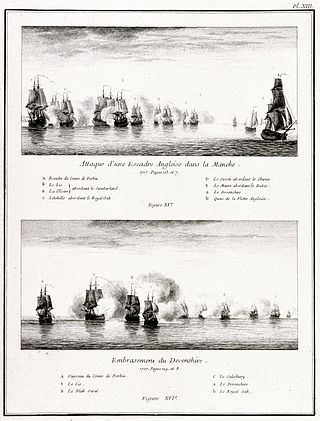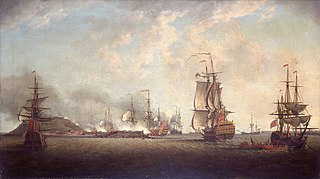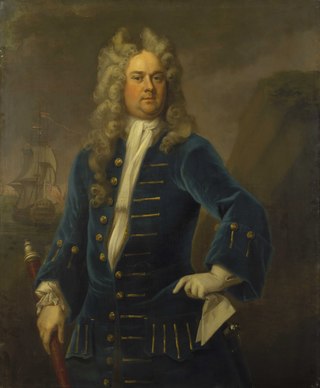Merhonour was a ship of the Tudor navy of England. It was built in 1590 by Mathew Baker at Woolwich Dockyard, and was rebuilt by Phineas Pett I at Woolwich between 1612 and 1615, being relaunched on 6 March 1615 as a 40-gun royal ship. It was then laid up at Chatham, only briefly returning to service in the 1630s. It was nevertheless considered to be one of the fastest ships in the Navy.
The Worcester was a 48-gun Third rate frigate built for the navy of the Commonwealth of England at Woolwich Dockyard by Master Shipwright Andrew Burrell and was launched in 1651). She was named for the Parliamentary victory at the Battle of Worcester.

HMS Salisbury was a 50-gun fourth rate ship of the line of the Royal Navy, one of eight such ships authorised by the Navy Board on 24 December 1695 to be newly built ; the others were the Hampshire, Dartmouth, Winchester, Worcester, Jersey, Carlisle and Tilbury. The contract for the Winchester was signed with shipbuilders Richard and James Herring in 1696, for the ship to be built in their yard at Baileys Hard on the Beaulieu River in Hampshire, England, and she was launched there on 18 April 1698.

Newcastle was a 44-gun fourth-rate frigate of the English Royal Navy, originally built for the Commonwealth of England by Phineas Pett the Younger at Ratcliffe, and launched in May 1653. By 1677 her armament had been increased to 54 guns.

HMS Neptune was a 90-gun second-rate ship of the line of the Royal Navy. She was built under the 1677 "Thirty Great Ships" Programme and launched in 1683 at Deptford Dockyard.
HMS Deptford was a 50-gun fourth-rate ship of the line of the Royal Navy, launched at Woolwich Dockyard in 1687. This was the second of three 50-gun ships ordered in 1682/3.
HMS Southampton was a 50-gun fourth rate ship of the line of the Royal Navy, ordered to be built by commercial contract by John Winter at Chapel, Southampton. The Southampton was launched on 10 June 1693.
HMS Anglesea was a 50-gun fourth rate ship of the line of the Royal Navy, launched at Plymouth in 1694, although not ordered from the dockyard, but as a commercial contract with Mr Flint, with labour and materials supplied from the dockyard by the Master Shipwright, Elias Waffe. She was ordered on 17 February 1692.

HMS Dartmouth was a 50-gun fourth-rate ship of the line of the Royal Navy, one of eight such ships authorised by the Navy Board on 24 December 1695 to be newly built ; the others were the Hampshire, Winchester, Salisbury, Worcester, Jersey, Carlisle and Tilbury. The contract for the Dartmouth was signed in 1696 with shipbuilder James Parker, for the ship to be built in his site in Southampton, taking the name of the previous Dartmouth of 1693, and she was launched there on 3 March 1698.
HMS Winchester was a 50-gun fourth rate ship of the line of the Royal Navy, one of eight such ships authorised by the Navy Board to be newly built ; the others were the Hampshire, Dartmouth, Salisbury, Worcester, Jersey, Carlisle and Tilbury. The contract for the Winchester was signed with shipbuilders John and Richard Wells in 1696, for the ship to be built in their yard at Greenland North Dockyard, in Rotherhithe, and she was launched there on 17 March 1698.
HMS Worcester was a 50-gun fourth rate ship of the line of the Royal Navy, one of eight such ships authorised by the Navy Board on 24 December 1695 to be newly built ; the others were the Hampshire, Dartmouth, Salisbury, Winchester, Jersey, Carlisle and Tilbury. The contract for the Worcester was signed with shipbuilder Robert Winter on 26 February 1696, for the ship to be built in his yard at Northam in Southampton, and she was launched there on 31 May 1698.
HMS Jersey was a 50-gun fourth rate ship of the line of the Royal Navy, one of eight such ships authorised by the Navy Board on 24 December 1695 to be newly built ; the others were the Hampshire, Dartmouth, Salisbury, Winchester, Worcester, Carlisle and Tilbury. The contract for the Jersey was signed with shipbuilder Joseph Nye on 31 July 1696, for the ship to be built in his yard at East Cowes on the Isle of Wight for a contract price of £8-2-6d per ton, and she was launched there on 24 November 1698.
HMS Tilbury was a 50-gun fourth rate ship of the line of the Royal Navy, one of eight such ships authorised by the Navy Board on 24 December 1695 to be newly built ; the others were the Hampshire, Dartmouth, Winchester, Salisbury, Worcester, Jersey and Carlisle. Construction of the Tilbury was awarded to Chatham Dockyard, where she was designed and built by Master Shipwright Daniel Furzer, and she was launched there on 3 September 1699 - the last of the eight ships to be finished.

HMS Chatham was a 50-gun fourth rate ship of the line of the Royal Navy, the first of five such ships to be ordered in 1690. The Chatham was built by Master Shipwright Robert Lee at the eponymous dockyard, and launched on 20 October 1691. She was designed to the same lines as Lee's previous 50-gun ship, the Sedgemoor of 1687 - her specification was for a length of 123 ft, breadth of 34ft 3in and depth in hold of 13ft 9in, although she measured very slightly more on completion.
HMS Rochester was a 50-gun fourth rate ship of the line of the Royal Navy, and the fifth such ship to be ordered in 1692. She was launched at Chatham Dockyard on 15 March 1693.

HMS Lichfield was a 50-gun fourth-rate ship of the line of the Royal Navy, one of five such ships authorised on 16 November 1693 (three to be built in different Royal Dockyards and two to be built by commercial contract. The Lichfield was built by Master Shipwright William Stigant at Portsmouth Dockyard and launched on 4 February 1695. She was first commissioned in that year under Captain Lord Archibald Hamilton, for service in Home Waters.
HMS Burlington was a 50-gun fourth rate ship of the line of the Royal Navy, built by Sir Henry Johnson's Blackwall Yard, and launched on 16 September 1695. The commercial contract had originally been agreed with Johnson on 16 November 1693, but the latter two were delayed and a fresh contract for them agreed on 7 December 1694.

HMS Guernsey was a 50-gun fourth rate ship of the line of the Royal Navy, one of four ordered in September 1694 to be built by commercial contracts; eight further ships of this type were ordered on 24 December. The Guernsey was built by Sir Henry Johnson's Blackwall Yard and launched on 6 July 1696.
HMS Nonsuch was a 50-gun fourth rate ship of the line of the Royal Navy, one of four ordered in September 1694 to be built by commercial contracts; eight further ships of this type were ordered on 24 December. The Nonsuch was built by Robert and John Castle at their Deptford shipyard and launched on 20 August 1696.
HMS Warwick was a 50-gun fourth rate ship of the line of the Royal Navy, one of four ordered in September 1694 to be built by commercial contracts; eight further ships of this type were ordered on 24 December. The Warwick was built by Robert and John Castle at their Deptford shipyard and launched on 20 August 1696.






